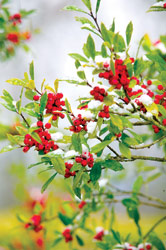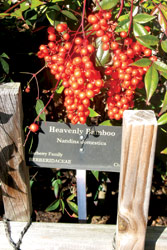For fair-weather hikers, winter is a time to hunker down around the fire perusing trail guides and gear catalogs while dreaming of spring. But for hardier souls, winter in the Southern Appalachians has its own rewards. A recent hike at The North Carolina Arboretum highlighted one of those seasonal pleasures: the winter berries whose vivid hues enhance the spare landscape.

Notable among them is the aptly named bittersweet. These festive orange berries — a trendy element of DIY holiday wreaths — crown an invasive species that chokes out indigenous flora. Hike leader Terry Dalton, the arboretum's sustainable-landscape curator, explained all this, hinting that bittersweet's pandemic spread may one day outpace kudzu.
But the insidious vine soon faded in favor of the crimson-studded shrubs and trees enjoying center stage this season in the arboretum's immediate grounds. Showiest among the December fruit is the simply named winterberry, a type of deciduous holly. Without leaves for contrast, winterberry trees exhibit beautifully against a cold, blue sky.
Small, royal-purple beautyberries are another deciduous Southeastern gem. Dalton, a passionate advocate of indigenous botanicals, even included the velvety, berry-packed cone of a staghorn sumac, another native tree that sheds its leaves. He went on to point out nandina, a charming shrub that's commonly known as heavenly bamboo. Keeping its foliage, the non-native nandina's hollylike impact has helped it enjoy major success as a landscape ornamental despite its invasive tendencies.
The curator seemed more partial to the native viburnum (known as snowball tree in summer), whose red fruits display a telltale translucence. Some types of viburnum are especially attractive to overwintering birds. In general, though, the reason certain berries are visible now is that they're a last-ditch food source.
"The trees that fruit in fall are their first choice," Dalton explained. "Anything that remains is not as tasty. The birds will go after winter berries only if they need to."
Thankfully, this season's heavy moisture has ensured a good crop of leftovers. "Lots of rain," he noted, "equals lots of berries."

Viewing and photographing the property's majestic American holly trees involves considerable neck-craning. Although one tends to think of this classic, barbed evergreen in sprigs, in its proper element the plant easily reaches a height of 40 feet and has been known to top 90. As with roses, certain choice holly cultivars are advanced for their dazzling presentation, such as the pleasingly named 'Miss Helen Holly' and 'Satyr Hill.'
At the far west end of the holly garden, Dalton identified a couple of examples of rare 'Winter Gold' trees. Diehard traditionalists, he said, "hate the sight of these yellow berries. They think the tree looks diseased." Others, however, are drawn to the startling color.
But if the gorgeous 'Winter Gold' can offend, the problem clearly lies in the prejudiced eye of the beholder. The fruits themselves, hardy as rock salt, can withstand the snub. Even the 50 mph winds that billowed around us during the winter-berry tour could not dislodge these amazingly resilient globules, Dalton emphasized.
But if winter berries don't drop until they're good and ready, the traffic lights along Brevard Road fared much worse that day. Snapped at their source by the fierce gusts, they left nothing round or red to guide drivers home.
Melanie McGee Bianchi is a stay-at-home mom and freelance journalist.
A recent hike at The North Carolina Arboretum highlighted winter berries, whose vivid hues enhance the spare landscape.



Before you comment
The comments section is here to provide a platform for civil dialogue on the issues we face together as a local community. Xpress is committed to offering this platform for all voices, but when the tone of the discussion gets nasty or strays off topic, we believe many people choose not to participate. Xpress editors are determined to moderate comments to ensure a constructive interchange is maintained. All comments judged not to be in keeping with the spirit of civil discourse will be removed and repeat violators will be banned. See here for our terms of service. Thank you for being part of this effort to promote respectful discussion.